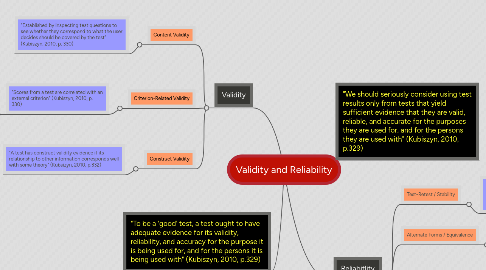
1. Validity
1.1. Content Validity
1.1.1. "Established by inspecting test questions to see whether they correspond to what the user decides should be covered by the test" (Kubiszyn, 2010, p. 330)
1.2. Criterion-Related Validity
1.2.1. "Scores from a test are correlated with an external criterion" (Kubiszyn, 2010, p. 330)
1.2.1.1. Concurrent criterion-related validity
1.2.1.1.1. "determined by administering both the new test and the established test to a group of respondents, then finding out the correlation between the two sets of test scores" (Kubiszyn, 2010, p. 330)
1.2.1.2. Predictive validity
1.2.1.2.1. "Refers to how well the test predicts some future behavior of the examinees. This...is particularly useful and important for aptitude tests" (Kubiszyn, 2010, p. 331)
1.3. Construct Validity
1.3.1. "A test has construct validity evidence if its relationship to other information corresponds well with some theory" (Kubsizyn, 2010, p.332)
2. "To be a 'good' test, a test ought to have adequate evidence for its validity, reliability, and accuracy for the purpose it is being used for, and for the persons it is being used with" (Kubiszyn, 2010, p.329)
3. Reliabitlity
3.1. Test-Retest / Stability
3.1.1. "Test is given twice and the correlation between the first set of scores and the second set of scores is determined" (Kubiszyn, 2010, p.341)
3.2. Alternate Forms / Equivalence
3.2.1. "Large differences in a student's score on two forms of a test that supposedly measures the same behavior would indicate an unreliable test" (Kubiszyn, 2010, p.343)
3.3. Internal Consistency
3.3.1. "Items ought to be correlated with each other, and the test ought to be internally consistent" (Kubiszyn, 2010, p. 343)
3.3.1.1. Split-half methods
3.3.1.1.1. "involves splitting the test into two equivalent halves and determining the correlation between them" (Kubiszyn, 2010, p.343)
3.3.1.2. Kuder-Richardson methods
3.3.1.2.1. "mesure the extent to which items within one form of the test have as much in common with one another as do the items in that one form with corresponding items in an equivalent form" (Kubiszyn, 2010, p.344)
